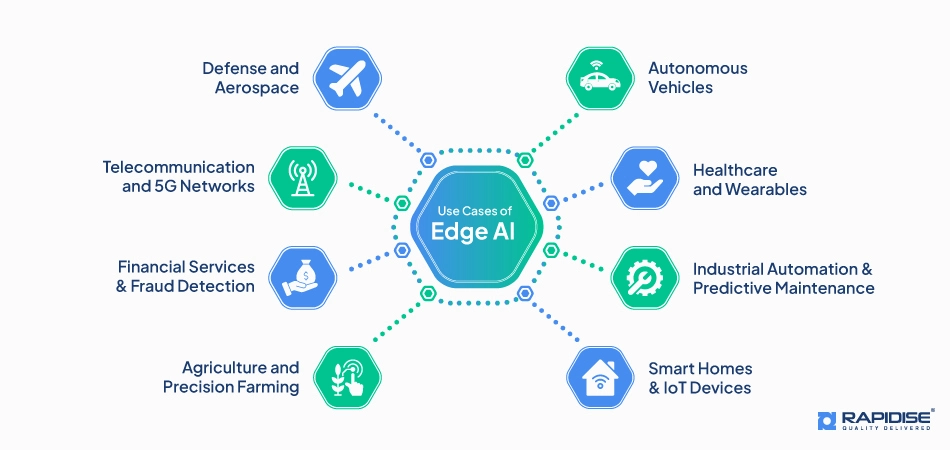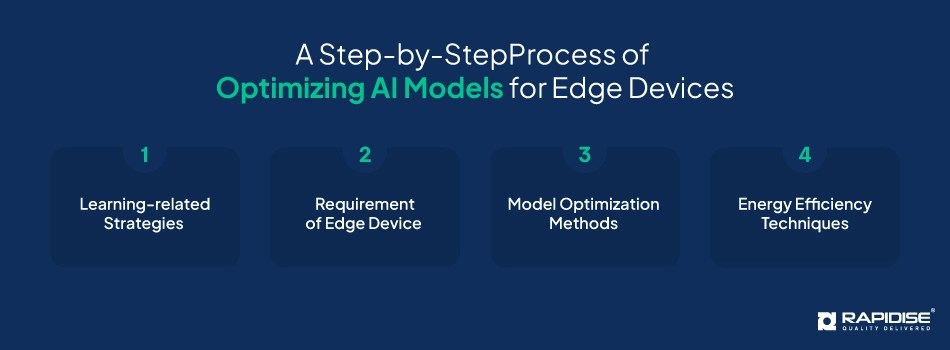Introduction
Because these devices face limitations related to hardware capabilities together with reduced energy performance and limited processing power. The process of optimizing AI models for edge devices serves the purpose of producing efficient system execution alongside lowered latency and better energy efficiency.
This blog examines every fundamental aspect of edge-driven AI model optimization through discussions about hardware boosting and compressive modeling approaches together with learning mechanism development and energy efficiency interventions.
Use Cases of Edge AI
These use cases have proven to be the most impactful among others:

Autonomous Vehicles
It employs Lane Departure Warning & Traffic Management to monitor road lanes while managing traffic activity to ensure driving safety. The system also utilizes AI-driven sensors to figure out time-sensitive collisions directly from sensor data while bypassing the need for cloud processing.
Healthcare and Wearables
The detection of early medical anomalies such as cardiac arrhythmias and diabetes warning signs takes place through AI analytical systems regardless of internet access. Medical equipment operating at the edge level provides on-site diagnostic ability to assess X-rays MRIs and ultrasound data in areas lacking traditional connectivity.
Industrial Automation and Predictive Maintenance
The use of AI-powered cameras throughout production lines enables them to detect product defects immediately. Laborer Protection Systems Utilize Sensors That Discover unsafe conditions to warn employees about possible threats.
Smart Homes and IoT Devices
Self-learning cameras identify familiar faces and detect strangers at the same time. The system learns how to manage heating cooling and lighting systems through user needs and energy use actions.
Agriculture and Precision Farming
Artificial Intelligence sensors adjust how water and nourishment is distributed by tracking the combination of weather conditions and soil dryness. AI systems observe animal health status while recording their behaviors and reproduction patterns to help farmers run their activities better.
Financial Services & Fraud Detection
Connected Customer Service systems made of AI-enhanced chatbots, and voice apps generate fast replies without needing cloud-based work. The tools in Algorithmic Trading scan stock industry patterns to make buying and selling deals instantly.
Telecommunication and 5G Networks
Telecom businesses use AI technology in their networks to improve performance results. Using AI technology networks determine future bandwidth needs and change their capacities properly. The technology updates base stations to process data immediately and improve mobile system performance. AI systems detect and stop security threats that occur on the network.
Defense and Aerospace
Battlefield Decision Support helps leaders make key decisions through the study of operational reports. A system at the edge uses AI to process satellite image data which assists emergency relief work and environmental tracking.
Launch the Maximum Potential of Edge AI Systems
Enhance your AI applications with cutting-edge optimization strategies
Hardware Optimization
Selecting an appropriate processing unit stands as the most vital element when optimizing hardware components. The utilization of Tensor Processing Units along with Vision Processing Units and Field-Programmable Gate Arrays as AI accelerators in devices delivers better operational capacities than traditional Central Processing Units and Graphics Processing Units work together.
The AI inference tasks run more efficiently on these purpose-built accelerators that operate with less power usage. AI-friendly Graphics Processing Units (GPUs) from NVIDIA Jetson as well as Google Coral improve both model execution speed and energy performance.
The crucial part of hardware optimization relates to effective memory management which remains essential. AI models need to be designed to use minimal internal memory while maintaining precise results across edge devices which usually have reduced storage and memory capacity.
Model pruning together with quantization techniques reduce memory usage which enables system performance preservation in devices with limited resources. Data pipeline optimization enables efficient handling of input-output data which prevents delays affecting real-time inference.
The successful operation of hardware requires thermal management to be fully optimized. The intense heat produced by AI calculations will cause gradual damage to operational efficiency. Average machine operating performance requires proper heat dissipation solutions including passive heat sinks and active cooling elements using either fans or liquid-based cooling systems.
Edge devices use ARM-based AI processors because these power-efficient components manage to offer high computational power capability with reduced energy consumption. AI model development requires hardware-software co-optimization because it allows practical adjustments for maximizing hardware capabilities.
The edge device performance becomes more efficient when using TensorFlow Lite and ONNX Runtime alongside PyTorch Mobile because these AI frameworks are optimized specifically for edge environments. AI workload-specific selection of hardware elements represents a fundamental requirement to strike performance-levels with efficiency and cost-effectiveness goals in edge AI implementations.
Firmware Optimization
Reducing boot time and memory overhead stands as one main approach in firmware optimization process. For real-time processing of AI models by edge devices both system startup delays and additional memory use must remain minimal because these factors reduce performance.
The optimization of firmware code through process streamlining and elimination of redundant steps and initial routine optimization results in faster device performance. AI inference benefits from the use of lightweight operating systems FreeRTOS and Zephyr and embedded Linux because these systems eliminate background processes that waste system resources.
Firmware power management stands to be an important factor to consider in this process. Changes to firmware must prioritize efficient power control since edge devices derive their power from batteries or meet strict energy requirements.
The system utilizes dynamic voltage and frequency scaling (DVFS) methods to modify its processing speed according to workload needs which results in lower power consumption when complete computational capacity is unnecessary. Energy efficiency benefits from implementing sleep and wake-up modes because they limit AI model execution to times when models are truly needed.
Security optimization stands as a necessary aspect of firmware design because edge devices usually process sensitive data. AI models gain protection from cyber threats along with unauthorized access because implementation of secure boot mechanisms and encryption for firmware updates and runtime integrity checks operates as protective measures.
The implementation of over-the-air (OTA) updates enables manufacturers to release firmware patches as well as performance enhancements without user-driven manual intervention thus maintaining edge AI devices with the latest update solutions. The system’s efficiency can be enhanced through firmware design features which enable hardware acceleration mechanisms.
Through set processor units (NPUs or GPUs) firmware enables speedier AI inferences and conserves processor CPU resources for different applications. The implementation of direct memory access (DMA) techniques as memory access patterns enables reduced data processing time which leads to decreased latency.
Separating AI model execution streams during real-time processing and the ability to run multiple tasks simultaneously through firmware multi-threading capabilities result in better system operation. Complex AI models can be processed smoothly by edge AI devices when task scheduling is optimized, and background tasks are eliminated while firmware receives updates for multiple core processing architectures.
Your AI Model Optimization Process Needs Expert Guidance
Our expert professionals at Rapidise provide detailed solutions with industry best practices.
A Step-by-Step Process of Optimizing AI Models for Edge Devices

A systematic approach must handle every aspect of edge device AI model optimization to achieve efficient processing along with minimized power use in real-time. This process details the optimization of AI models for edge deployment through essential methods. This includes learning strategies together with model compression and optimization approaches as well as testing procedures.
Learning-related Strategies
Federated Learning
The approach protects sensitive data security because the information stays safely on the device system. Through federated learning techniques organizations reach two major benefits: they decrease bandwidth utilization while also obtaining real-time model modifications that prove especially useful for applications requiring personalized service and predictive capabilities along with health monitoring tasks.
Deep Transfer Learning (DTL)
Achieving efficient AI task execution on edge devices becomes possible because this method decreases computation requirements. DTL proves efficient for medical diagnostics since it allows doctors to adapt generalized medical image AI models onto specific diseases using small diagnostic datasets.
Knowledge Distillation
The student model learns through copying the soft output predictions combined with intermediate feature representations that the teacher model provides which makes it applicable on devices with limited resources. Knowledge distillation serves many applications including voice recognition along with facial recognition and object detection because it is necessary to achieve real-time performance through model efficiency.
Requirement of Edge Device
The requirements for hardware setups adjust depending on which application needs the systems. The processing requirements for drone applications demand weight-efficient and power-saving processors yet industrial robots implement high-performance GPUs or TPUs for their functionality.
Sensor integration represents a major design factor when using edge AI models because such models depend on real-time sensor information from cameras and LiDAR and accelerometers along with additional hardware devices.
The smooth operation of hardware components together with AI models produces greater processing efficiency. The selected device needs to back AI frameworks consisting of TensorFlow Lite and ONNX and supporting PyTorch Mobile for achieving efficient deployment capabilities.
Model Optimization Methods
Model optimization stands as an essential practice which enables effective operation of AI models on restricted edge devices. Work done on improving these models results in better performance capabilities of edge devices together with minimal latency requirements and power efficiency objectives.
Pruning
Neural networks benefit from pruning due to connection and neuron removal because the operation decreases system complexity. Fundamentally structured pruning techniques remove entire layers as well as entire channels, but unstructured pruning focuses on individual weights. Image recognition and NLP models benefit most from this optimization method because it enables identification of unimportant final prediction neurons.
Quantization
The process of quantization reduces memory requirements by replacing floating-point numbers with integer-based data representatives. Two well-known techniques for optimizing edge device AI work and power consumption are post-training quantization together with quantization-aware training methods.
Weight Sharing
The Weight sharing technique provides memory efficiency because it organizes similar weights into one shared value. RNNs along with large-scale deep learning models tend to incorporate this technique for their operation.
Matrix Decomposition
The edge computational process benefits from Singular Value Decomposition (SVD) which splits weight matrices into smaller components that enable efficient matrix multiplication operations. Deep learning models become more economical through the implementation of this technique.
Stochastic Gradient Descent (SGD)
The optimization method SGD makes sequential weight updates through randomly chosen information points. Through the implementation of mini-batch gradient descent the system completes efficient training operations without allowing edge devices to surpass their memory capacity.
Gradient Scaling in Network Quantization
The technique enables better gradient optimization in quantized networks to achieve enhanced training reliability and precise model prediction especially during low-bit operations.
Regularization
Edge deployment benefits from the use of L1 and L2 penalties because they support overfitting prevention and enhance model generalization abilities.
Hyperparameter Tuning
Through adjustments made to learning rate and activation functions along with batch size optimization edge devices experience both higher model performance results and faster computation capabilities which make them ready for deployment.
Testing and Fine-tuning
Testing with real-world datasets takes place after optimization to check performance metrics including accuracy and latency as well as power usage. The model operates best in edge environments through fine-tuning procedures.
Energy Efficiency Techniques
The efficient optimization of AI models destined for edge devices requires energy-saving mechanisms.
- Neural Architecture Search (NAS) and Hardware-Aware NAS: Hardware-Aware NAS together with Neural Architecture Search optimizes neural network structures to discover the best accuracy vs efficiency relation.
- Algorithm-Accelerator Co-Design Method: Algorithm-Accelerator Co-Design Method works by designing AI models with a purpose to take full advantage of hardware acceleration features.
- Memory Optimization: The optimization of memory through efficient memory management techniques reduces unplanned memory access points which leads to decreased energy usage.
- Energy-Efficient Communication Protocols: The protocols work to maintain efficient data transfer between devices through power-effective communication methods.
- Communication Efficiency with Gradient Compression: The application of Gradient Compression technique enables smaller updates in model data which leads to enhanced communication speed during real-time operation.
- Gradient Checkpointing: Gradient Checkpointing acts as a resource saver which chooses selected intermediate gradients for storage and minimizes memory usage.
- Shared Memory Concept: Multiple processes efficiently access shared memory as part of the Shared Memory Concept which enables optimized parallel computational operations in edge devices.
Delineating the AI Model Optimization Framework
The AI model optimization framework implements a carefully developed sequential process which integrates data cleansing with model algorithm selection and compression methods and optimization solutions as well as real-time operational testing. AI performance enhancement on edge devices becomes systematic through the implementation of this framework by AI engineers.
- To obtain high-quality data for testing and training purposes the first step comprises data collection and preprocessing processes.
- Lightweight models receive selection preference along with compression implementation as part of the framework. Hardware-Specific Optimizations – Tailoring the model to leverage device-specific accelerators.
- Testing under realistic scenarios alongside required modifications serves as the second stage of development.
- AI models become operational on edge devices with both low power needs and maximum accuracy when utilizing this operational framework.
Conclusion
These strategies create favorable conditions for AI-driven edge applications to work with fast response times and low operational expenses and wider deployment possibilities. German automobiles and medical treatments and industrial robotics exist today because edge AI replaced cloud dependency as an intelligence infrastructure for devices.
